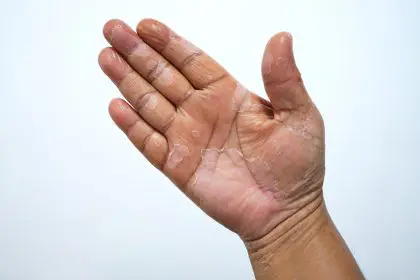Your hands might be revealing your age more than your face—and there’s science to explain why. While many focus on facial skincare routines, hands often receive minimal attention despite being constantly exposed to environmental stressors. This comprehensive guide explores the biological and environmental factors behind accelerated hand aging and provides practical prevention strategies to maintain youthful-looking hands.
The skin structure difference
The skin on your hands differs significantly from facial skin in several important ways. Hand skin is naturally thinner, with less subcutaneous fat providing structural support. This thinner dermal layer contains fewer oil glands, making hand skin more prone to dryness and reduced elasticity.
Meanwhile, facial skin benefits from a more robust structure with a thicker dermis layer, more sebaceous glands for natural moisturization, and higher collagen density. These structural differences become increasingly apparent with age as hands lose volume and develop a more translucent appearance that reveals veins, tendons, and bones underneath.
Constant sun exposure
Hands receive nearly continuous ultraviolet radiation exposure throughout life. Unlike facial skin, which many people routinely protect with SPF products, hands often go unprotected during daily activities. This cumulative sun damage accelerates photoaging through the breakdown of collagen and elastin fibers.
UV radiation triggers the production of matrix metalloproteinases, enzymes that degrade collagen, leading to reduced skin thickness and elasticity. The resulting photodamage manifests as dark spots, uneven pigmentation, and textural changes that age hands prematurely compared to areas with consistent sun protection.
Frequent washing and sanitizing
The 2020s brought unprecedented attention to hand hygiene, but the frequent washing and sanitizing take a significant toll on hand skin health. Multiple daily washing sessions strip natural oils from the skin barrier, while alcohol-based sanitizers further dehydrate and compromise skin integrity.
This repetitive cycle disrupts the acid mantle—the protective film on skin surface—leading to increased transepidermal water loss. The resulting chronic dryness accelerates fine line formation and contributes to a crepe-like texture that ages hands visibly faster than facial skin, which typically undergoes gentler cleansing routines.
Chemical exposure
Hands regularly encounter harsh chemicals in cleaning products, detergents, and solvents that facial skin rarely contacts. These chemical agents strip protective lipids from the skin, disrupt barrier function, and cause inflammatory reactions that accelerate aging processes.
Common household products contain surfactants that dissolve the intercellular lipids maintaining skin barrier integrity. Professional exposure to chemicals in industries like hairdressing, cleaning, and healthcare further compounds this damage. The resulting chronic irritation leads to collagen breakdown, hyperpigmentation, and structural changes that manifest as premature aging.
Neglected skincare routines
While multi-step facial skincare routines have become mainstream, hands often receive minimal attention beyond basic moisturizing. This skincare inequality means hands miss out on beneficial ingredients like retinoids, antioxidants, and peptides that could help maintain youthful appearance.
The absence of targeted treatments for hands means accumulated damage goes unaddressed, while facial skin benefits from specialized formulations addressing specific concerns. This care discrepancy becomes increasingly visible with age, with hands often appearing decades older than well-maintained facial skin.
Volume loss and fat redistribution
Natural aging brings gradual loss of subcutaneous fat throughout the body, but this process affects hands particularly visibly. The minimal fat padding in hands diminishes further with age, revealing underlying anatomical structures and creating a skeletal appearance associated with advanced age.
This fat atrophy occurs alongside collagen depletion, reducing the plump, smooth appearance of youthful hands. While facial volume loss can be partially masked by bone structure or compensated for through targeted skincare, hands provide fewer opportunities to disguise these structural changes.
Repetitive motion and mechanical stress
Hands perform countless repetitive movements daily, creating mechanical stress that facial skin rarely experiences. These repeated motions—typing, gripping, bending—stress collagen fibers along movement lines, eventually forming permanent creases and textural changes.
The constant flexing and extending of hands leads to reduced elasticity along stress points, particularly on knuckles and between fingers. This mechanical aging combines with other factors to accelerate the visible aging process beyond what facial skin typically experiences.
7 effective strategies to prevent hand aging
- Daily sun protection forms the foundation of hand anti-aging. Apply broad-spectrum SPF 30+ sunscreen to hands every morning, extending application to wrists and forearms. Reapply after washing and every two hours during extended outdoor exposure. Consider driving gloves for long commutes, as car windows allow aging UVA rays to penetrate.
- Intensive moisturization helps counteract the drying effects of frequent washing and environmental exposure. Apply emollient-rich hand creams containing humectants like glycerin and hyaluronic acid to draw moisture into the skin, alongside occlusive ingredients like shea butter or petrolatum to seal hydration. Keep travel-sized hand cream options in multiple locations for consistent application.
- Protective habits significantly reduce environmental damage. Wear gloves during cleaning, gardening, and dishwashing to minimize chemical and water exposure. Cotton-lined rubber gloves provide both protection and comfort during household tasks, while lightweight cotton gloves can be worn overnight with intensive treatments for enhanced penetration.
- Advanced ingredients address existing signs of aging. Incorporate retinol hand creams several nights weekly to stimulate collagen production and cell turnover. Products containing niacinamide help strengthen the skin barrier and reduce pigmentation, while vitamin C serums brighten discoloration and support collagen synthesis. Extend facial antioxidant products to hands before they expire.
- Professional treatments offer more dramatic improvement for established aging signs. Chemical peels using alpha-hydroxy acids can reduce pigmentation and improve texture, while laser treatments target stubborn dark spots and stimulate collagen production. Injectable dermal fillers restore lost volume in hands, immediately reducing the skeletal appearance associated with aging.
- Nutritional support builds skin resilience from within. Foods rich in antioxidants, omega-3 fatty acids, and collagen-supporting nutrients contribute to improved skin structure and function. Staying properly hydrated maintains skin plumpness and supports optimal cellular function throughout the body, including hand skin.
- Gentle cleansing habits preserve skin barrier function. Use lukewarm rather than hot water when washing hands, and select pH-balanced, sulfate-free cleansers that clean effectively without stripping natural oils. Apply moisturizer immediately after washing while skin remains slightly damp to trap hydration.
Implementing these preventive strategies can dramatically slow hand aging progression and even reverse existing damage. With consistent care, hands can maintain a youthful appearance that matches well-maintained facial skin, preventing the age-revealing disconnect many experience. The key lies in extending the same thoughtful attention to hand care that many already devote to facial skincare.















